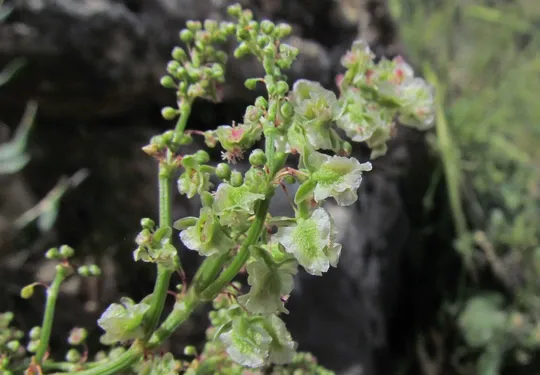Rumex aeroplaniformis


Rumex rothschildianus now
grows in Israel only in the Sharon:
mainly in the Hof HaSharon National Park in Shfayim, in Rishpon and Nof-Yam. In the Wadi Poleg reserve there was a small
natural population at least until the mid-1990s. The last survey (Nave, 2001) found only two natural sites there. Other populations that were previously found in the Sharon – in Binyamina, Caesarea and Udim – are extinct. In the late 1920s, it was also collected in Bne Berak in the Philistian Plain.
Sandy
hamra, sandy calcareous regosol and crumbly
calcareous sandstone, sometimes on eroded areas and sheltered slopes. On
most of the sites where Rumex rothschildianus populations currently grow the influence of the sea spray has a
visible effect. R. rothschildianus grows together with Lycium schweinfurthii, characteristically
accompanied by Dedmostachya bipinnata, Aegilops sharonensis, Anthemis
leucanthemifolia and Trifolium palaestinum.
The genus Rumex has 200 species in temperate regions. R. rothschildianus belongs to the Acetosa sub-genus. It is an isolated species, characterized by the unique shape of its fruit. Aaron
Aaronsohn first described the species in 1906 and named it for Baron Rothschild.
Loss of habitats due
to accelerated development in
the coastal plain is the main reason for
the decrease in Rumex rothschildianus sites. Fifteen sites were recorded in Israel
prior to 1965, but only two, or possibly three
are known today.
• R. rothschildianus populations are often found in patches numbering
tens to about 1000 plants. The size of
these patches is apparently stable when they grow
under
undisturbed conditions. The sites are isolated from each other. The probability of gene exchange via pollination is very low due to their isolation. Dispersal is local, consequently
there appears to be no dispersal unit transfer between patches. Despite its good germination capability R. rothschildianus does not spread beyond the limited patches in which it grows today; this may be due to its low competitive
ability.
•
R. rothschildianus populations number from
a few dozen to several hundred plants at each site. Population
size exhibits significant annual fluctuations, which reflects the different germination
and establishment proportions. There is no information on long-term population
size increase or decrease trends.
• R. rothschildianus is endemic to Israel, and its extinction in Israel signifies its global
extinction.
• Several naturalization
attempts were
made in the 1980s and 1990s in the Bne
Tsion and Wadi Poleg nature reserves, with seeds from Rishpon. Germination was successful and for a few years dozens
of plants were observed annually on the seeded plots, but there is no certainty regarding their long term survival in the new plots.
The areas in which Rumex
rothschildianus is protected within
nature reserves or national parks (Hof HaSharon National Park) should be expanded. The
existing populations should be fenced and monitored and trends in their annual
dynamics should be studied. Controlled
establishment of additional populations
within protected areas by reseeding suitable soils should be
considered.
Rumex rothschildianus
is endemic and grows only on Israel’s coastal plain.
Rumex rothschildianus is a very rare, critically endangered annual plant, endemic to Israel. It grows at 2-3 sites on sandy soils in the Sharon. Its natural habitat is very sensitive to
development. Currently R. rothschildianus is only protected in the
Wadi Poleg Reserve, but it also grows
within the boundaries of the Hof HaSharon National Park. R. rothschildianus populations should be prioritized for conservation and restoration.
פולק, ג. 1984 מבחר מיני צמחים אופייניים לחמרה וכורכר – חומעת האוירון. רתם 13: 139-141
נוה, א. 2001. סיכום הפעילות לאישוש אוכלוסיות חומעת האווירון, חוף השרון, 1996–2001. רשות הטבע והגנים.
Dafni, A. and Heyn, C.C. 1978. Rumex rotschildianus. In: Lucas, G. and Singh, H (eds.). The IUCN plant red data book. IUCN, Morges, Switzerland.
Rottenberg, A. 2001. Rumex rothschildianus, an endemic-to-Israel species, on the verge of global extinction. Israel Journal of Plant Sciences 49: 57-60.
Current Occupancy Map
| 1000 squre meter pixel | 5000 squre meter pixel | 10000 squre meter pixel | |
|---|---|---|---|
| number of observations | 0 | 0 | 0 |
| in total pixels | 0 | 0 | 0 |
| Family | Polygonaceae |
| Classification | On the endangered species list |
| Ecosystem | Mediterranean on Coastal area |
| Chorotype | Eastern Mediterranean |
| Conservation Site | Hof HaSharon National Park, south east of Shfayim |
| Rarity |
1
5
6
|
|---|---|
| Vulnerability |
0
4
4
|
| Attractiveness |
0
0
4
|
| Endemism |
0
4
4
|
| Red number |
1
6.8
10
|
| Peripherality | 0 |
| IUCN category | DD EW EX LC CR EN VU NT |
| Threat Definition according to the red book | Critically endangered |
 Based on:
Based on:






